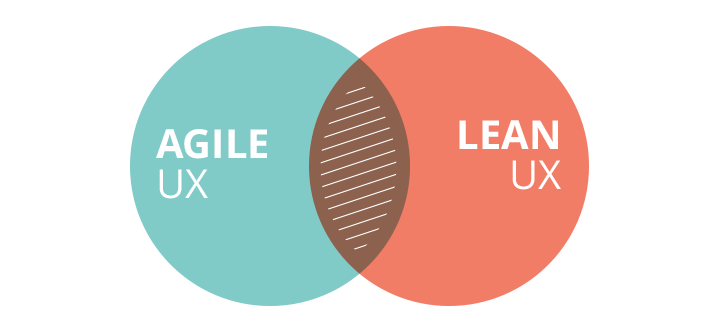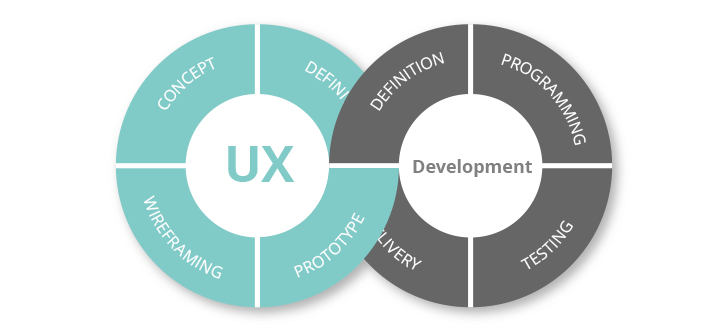Choosing a UX Strategy that suits you and your users: Agile Vs Lean UX

The advent of Agile and Lean UX in everyday tech conversation can confuse the best of us. Both relate to user experience design, but what’s the difference between the two?
With so many UX strategies and techniques floating around it’s amazing we see eye to eye on anything. When it comes to the right UX strategy, there is no one size fits all. We should opt for what works best for our business, and for our users. Today, we’re talking about how Agile and Lean UX strategies can help or hinder your software development.
Essentially, Agile UX produces a more polished product whilst Lean UX produces multiple products of increasing polish. Let’s dive right in to the details!
An introduction to Lean UX
Lean was designed to cut waste and optimize operational efficiency while providing great customer value. Martin Treder explains that “the Lean concept sees that a business must ship a product as soon as possible”. However, instead of prepping for a shippable product, Lean produces a minimum viable product (MVP). This MVP is then taken to market ASAP.
Lean UX unites this product development model with user-centered business techniques, through “constant measurement and learning loops” (build – measure – learn). The objective is to find the fastest way to achieve end goals, with less focus on documentation. Anthony Vivano from Smashing Magazine outlines the goals of Lean UX:
- Valuing early customer validation over releasing products with unknown end-user value – often starting with paper prototyping and ending with high-fidelity prototyping
- Establishing collaborative design over designing on an island
- Solving user problems over designing the next “trend-setting” feature
- Applying appropriate tools over following a rigid plan
- Opting for nimble design over heavy wireframes, comps or specs
The good, the bad and the lean
Lean UX is a collaborative approach to UX strategy. It fosters open, collaborative, and iterative processes that intend to break through organizational “red tape”. A Lean UX team normally consists of a handful of industry experts, like creative directors, designers and developers. It encourages cross-team collaboration and feedback throughout the development process.
The Lean UX model aims at saving time and resources through constant iterations and review. Collaboration with customers is also placed at the heart of Lean UX, giving the team an understanding of the problems that their customers face.
Lean UX is not a process in which each tool is rigidly applied. Lean is ideal if fast and efficient end results are needed: choose a feature to test, do it well, and iterate it by releasing early and releasing often.
Some say that Lean UX is perhaps too lean. To arrive at what is truly valuable to the consumer, we need to overproduce and throw stuff away—we know this. We learn about our users from “waste”. But, if you have an idea to test and you want to ‘fail fast’ and succeed sooner, then Lean UX could be UX strategy.
The basics of Agile UX
Agility: “marked by ready ability to move with quick, easy grace.”
Agile originates from software creation. It focuses on team collaboration and efficiency. As outlined in this UserZoom article, Agile UX describes the combining of Agile Software Methodology with UX Design methods and follows a set of simple principles:
- Valuing individuals and interactions over processes and tools
- Creating working software over comprehensive documentation
- Establishing customer collaboration over contract negotiation, and
- Responding to change over following a fixed, anticipated plan
Software development driven by Agile uses the principles of the Project Management Triangle – cost, scope, and schedule – to determine the quality of a project. With the user-centric design movements that we currently find ourselves in, customrs are also more involved in product definition.
This is where UX comes into play. The understanding of complex user interactions and behaviors has earned its place in the world of Agile, with the growing need for testing and iterations of design concepts. The way that UX comes into Agile is through Scrum.
According to UserZoom, “When we think about integrating UX and testing within software development, we need to think about how to fit into an existing agile model, such as Scrum or Kanban“. This type of workflow is based on a ‘backlog’: a “collection of requirements in the form of short user stories”, a sort of ‘to-do list’ for web, product and marketing tasks.
The team can extract micro-jobs and start to plan ‘sprints’ that are then worked on over a set number of days or weeks, These are typically in 2-4 week increments, though the amount of time needed can differ substantially per task.
The nitty gritty of Agile UX
Agile UX is designed to ensure usability for the consumer. As products and services evolve more rapidly in the digital space, the end-users also become more sophisticated and harder to define.
UXers have to define each user persona with care. In order to do this, companies need to perform user research so as to deliver a user-driven product. Agile UX is designed to be more responsive to customer demands. Increased cross-team and customer collaboration are characteristics of Agile UX.
Agile UX is great when you’re looking to test against fixed outcomes because you test and verify on a regular basis, and understand each change made. Agile UX shines when there is a known requirement in a project.
Going Agile requires having a fast prototyping tool – download Justinmind for free and try it out!
For example, in an environment where features must be shipped double-quick time, the setting of time limits on activities – timeboxing– allows you to ship faster and organize better. Agile UX allows you to set a budget (e.g. the number of sprints) and increase or decrease the number of features to be worked on. This progress tracking allows for a constant level of quality and efficiency: happy team, happy end-user.
The potential downside of Agile UX is that, in focusing on the efficiency of the software development process, it does not include design, particularly when it comes to Scrum. In Agile culture, there is no particular place built in for design—this has to be created.
Agile UX is not designed to tell you what to build, only how to build it faster and with less risk. At the end of the day, the goal of Agile is to have a potentially shippable product that has been designed, tested and is functional, in a matter of weeks. If you’re looking to release a fully realized version under such conditions, look to Agile UX.
The latest & greatest: ‘lean agile’
Followers of agile and lean methodologies understand the importance of striking the right balance, instead of going to extremes. Some say that lean and agile methodologies are complementary in that becoming lean makes you more agile (and vice versa). But what if that’s just not enough? How about we take it a step further?
Lean agile describes the attempt to truly capture a collaborative, flexible team environment. Imagine a way to best match the natural pace of how people and teams actually work in order to increase efficiency and improve the end-result.
With Lean Agile, projects are broken down into smaller ‘right-sized stories’, listed and prioritized in a backlog. Then each story is worked on continuously. After speaking with the client, there should be an understanding of the minimum viable product to ship.
Continuous integration of Lean Agile allows for the MVP to maintain functionality while other features are added. It also exposes defects right away instead of leaving them to a final testing phase.
The advantages of this method include:
- Stakeholders can view and measure progress based on kanban boards and are able to customize, pause or stop the project at any given point.
- Team members have more autonomy where it counts, allowing them to get on with their work, train each other, and encourage diversification and integration of work across teams.
- We can adopt a more efficient method of measuring project requirements, including project time frames. People can work to the client’s budget, and the project as a whole will refine over time as the client requires certain features.
Lean UX vs Agile UX: the takeaway
It should come as no surprise that organizations need to be adaptive and flexible to meet the needs of users. Ultimately, both the Agile UX and Lean UX techniques can arrive in the same place, but via very different routes. When choosing which path to take for your software projects, determine the most appropriate path for your end result, not which strategy is currently trending!
Related Content
 Why should you use user personas and how do you create them? Get all the steps to build one, as well as a great example and a list of user persona generators!15 min Read
Why should you use user personas and how do you create them? Get all the steps to build one, as well as a great example and a list of user persona generators!15 min Read UX design books that cover everything from layout design to the theory of user testing. Want to expand your horizons? Check out this awesome list!9 min Read
UX design books that cover everything from layout design to the theory of user testing. Want to expand your horizons? Check out this awesome list!9 min Read UX design portfolios are your chance to showcase your top skills and best work. Check out this post for awesome portfolio examples and websites!10 min Read
UX design portfolios are your chance to showcase your top skills and best work. Check out this post for awesome portfolio examples and websites!10 min Read





